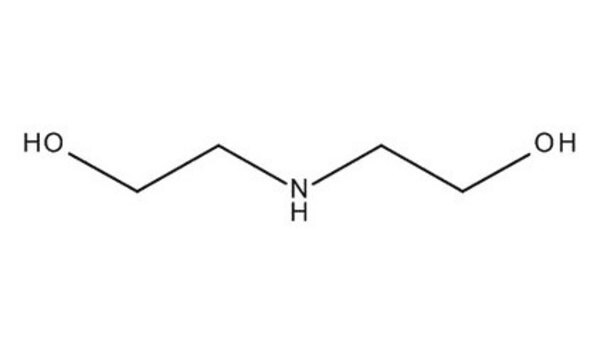D83303
Diethanolamine
99%
Synonyme(s) :
2,2′-Iminodiethanol, Bis(2-hydroxyethyl)amine
About This Item
Produits recommandés
Densité de vapeur
3.6 (vs air)
Pression de vapeur
<0.98 atm ( 100 °C)
Essai
99%
Forme
solid
Température d'inflammation spontanée
689 °F
Limite d'explosivité
10.6 %
Indice de réfraction
n20/D 1.477 (lit.)
pb
217 °C/150 mmHg (lit.)
Pf
28 °C (lit.)
Densité
1.097 g/mL at 25 °C (lit.)
Chaîne SMILES
OCCNCCO
InChI
1S/C4H11NO2/c6-3-1-5-2-4-7/h5-7H,1-4H2
Clé InChI
ZBCBWPMODOFKDW-UHFFFAOYSA-N
Vous recherchez des produits similaires ? Visite Guide de comparaison des produits
Mention d'avertissement
Danger
Mentions de danger
Conseils de prudence
Classification des risques
Acute Tox. 4 Oral - Eye Dam. 1 - Repr. 2 - Skin Irrit. 2 - STOT RE 2 Oral
Organes cibles
Kidney,Liver,Blood
Code de la classe de stockage
11 - Combustible Solids
Classe de danger pour l'eau (WGK)
WGK 2
Point d'éclair (°F)
280.4 °F - closed cup
Point d'éclair (°C)
138 °C - closed cup
Équipement de protection individuelle
Eyeshields, Faceshields, Gloves, type ABEK (EN14387) respirator filter
Faites votre choix parmi les versions les plus récentes :
Déjà en possession de ce produit ?
Retrouvez la documentation relative aux produits que vous avez récemment achetés dans la Bibliothèque de documents.
Les clients ont également consulté
Notre équipe de scientifiques dispose d'une expérience dans tous les secteurs de la recherche, notamment en sciences de la vie, science des matériaux, synthèse chimique, chromatographie, analyse et dans de nombreux autres domaines..
Contacter notre Service technique










